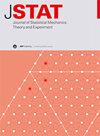弱驱动力优化协议的分析解决方案
IF 1.9
3区 物理与天体物理
Q2 MECHANICS
Journal of Statistical Mechanics: Theory and Experiment
Pub Date : 2024-07-14
DOI:10.1088/1742-5468/ad5c57
引用次数: 0
摘要
科学的主要目标之一是在某些特定制度下识别特定现象的一般模式。在这项工作中,通过分析表达最优方案,使有限时间、等温和弱过程的热力学功及其方差最小化,从而实现了这一目标。求解欧拉-拉格朗日积分方程的方法非常通用,只取决于最优协议的时间反向对称性,这在所考虑的制度中得到了普遍证明。解由一条直线和边界跳跃项以及脉冲项组成。推导出了已知结果,并解决了许多新问题,证实了这一模式。在适当的渐近极限中推导出了慢变和突变情况。由于目前的文献方法无法在分布空间中产生解,因此与数值程序的比较受到限制。本文章由计算机程序翻译,如有差异,请以英文原文为准。
Analytical solution for optimal protocols of weak drivings
One of the main objectives of science is the recognition of a general pattern in a particular phenomenon in some particular regime. In this work, this is achieved with the analytical expression for the optimal protocol that minimizes the thermodynamic work and its variance for finite-time, isothermal, and weak processes. The method that solves the Euler–Lagrange integral equation is quite general and depends only on the time-reversal symmetry of the optimal protocol, which is proven generically for the regime considered. The solution is composed of a straight line with jumps at the boundaries and impulse-like terms. Already known results are deduced, and many new examples are solved corroborating this pattern. Slowly-varying and sudden cases are deduced in their appropriate asymptotic limits. Comparison with numerical procedures is limited by the nonavailability of the present methods of the literature to produce solutions in the space of distributions.
求助全文
通过发布文献求助,成功后即可免费获取论文全文。
去求助
来源期刊
CiteScore
4.50
自引率
12.50%
发文量
210
审稿时长
1.0 months
期刊介绍:
JSTAT is targeted to a broad community interested in different aspects of statistical physics, which are roughly defined by the fields represented in the conferences called ''Statistical Physics''. Submissions from experimentalists working on all the topics which have some ''connection to statistical physics are also strongly encouraged.
The journal covers different topics which correspond to the following keyword sections.
1. Quantum statistical physics, condensed matter, integrable systems
Scientific Directors: Eduardo Fradkin and Giuseppe Mussardo
2. Classical statistical mechanics, equilibrium and non-equilibrium
Scientific Directors: David Mukamel, Matteo Marsili and Giuseppe Mussardo
3. Disordered systems, classical and quantum
Scientific Directors: Eduardo Fradkin and Riccardo Zecchina
4. Interdisciplinary statistical mechanics
Scientific Directors: Matteo Marsili and Riccardo Zecchina
5. Biological modelling and information
Scientific Directors: Matteo Marsili, William Bialek and Riccardo Zecchina

 求助内容:
求助内容: 应助结果提醒方式:
应助结果提醒方式:


